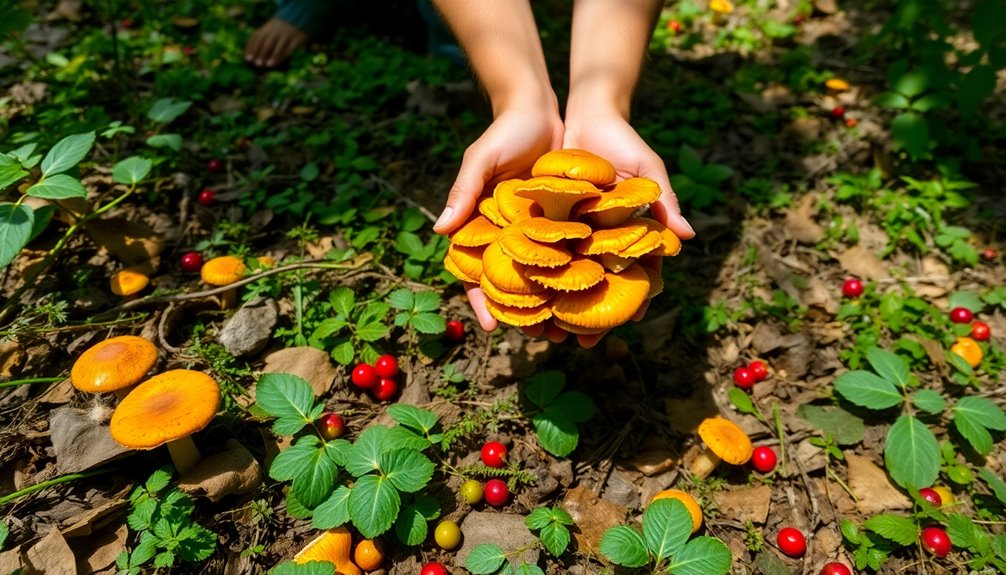To establish forage grasses, start with thorough soil testing to assess pH and nutrient levels. Improve your soil by incorporating organic matter and adjusting pH to 5.8-6.2. Choose disease-resistant grass varieties suitable for your local climate, and time your planting right—warm-season grasses need warm soil, while cool-season can be planted from August to November. Once established, manage grazing effectively to prevent overgrazing and promote regrowth. Regularly monitor pasture health and soil nutrition. These surprising steps can transform your pasture into a lush landscape, and there's even more to discover about maximizing your grass growth.
Key Takeaways
- Conduct soil tests to determine pH and nutrient levels, adjusting as needed for optimal forage growth.
- Choose suitable forage species based on local climate, prioritizing disease-resistant varieties for better yields.
- Time planting correctly, with cool-season grasses sown in late summer and warm-season grasses in late spring.
- Implement rotational grazing practices to enhance pasture regrowth and prevent overgrazing, maintaining healthy root systems.
- Utilize innovative techniques like no-till seeding and overseeding to improve pasture quality and resilience.
Planning and Preparation

Starting your pasture establishment journey requires careful planning and preparation to set you up for success.
You'll want to begin with a soil test to assess pH and nutrient levels. This essential step helps you understand your soil's health and guides your management plan. By knowing what your soil needs, you can make informed decisions about fertilizers and amendments.
Incorporating organic matter into your soil is another key aspect of your preparation. Organic matter improves soil structure and drainage, which prevents waterlogging and promotes healthy grass growth.
When you enhance your soil's fertility, your pasture will thrive.
Additionally, identify specific challenges you may face, such as erosion or poor drainage, and develop strategies to address them in your management plan.
Don't hesitate to utilize resources like local agricultural extensions and county agents. They can provide tailored advice, ensuring you're on the right track.
Selecting the Right Plants
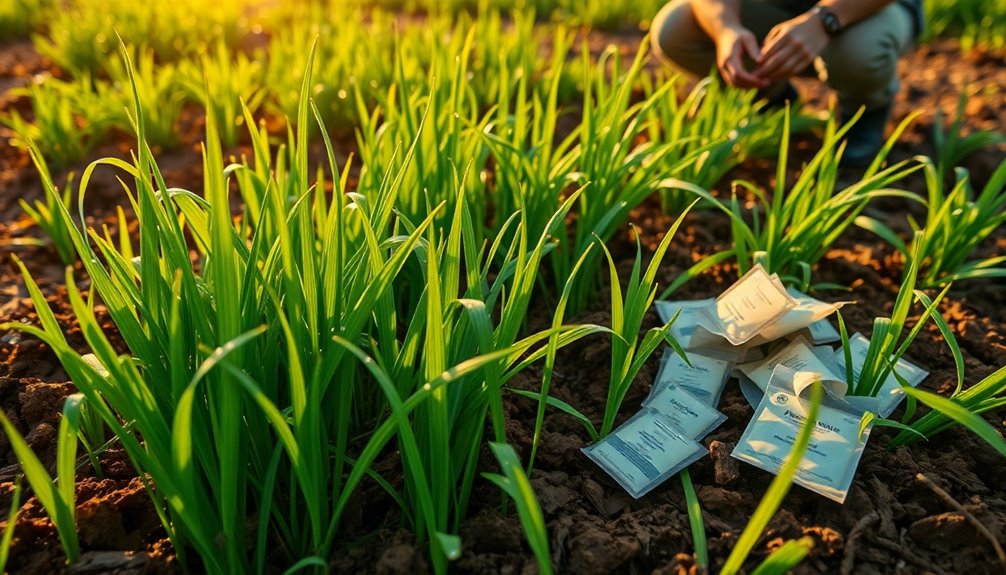
When selecting forage plants, it's essential to take into account your local climate and soil conditions to guarantee they thrive.
Prioritizing disease resistance and incorporating native species can greatly enhance your pasture's resilience and productivity.
Local Climate Suitability
Considering local climate and soil conditions is essential for successfully establishing forage grasses. To achieve local climate suitability, you need to select forage species that thrive in your specific environment. For example, bahiagrass is ideal for the Florida Panhandle due to its adaptability.
Here are some tips to help you choose the right plants:
- Conduct soil tests to assess pH and nutrient levels before planting.
- Consult local agricultural extensions for tailored advice on suitable forage varieties.
- Avoid unsuitable species that don't match your region's climate, like fescue in warmer areas.
- Consider disease resistance and growth rates, as native species often show better resilience.
- Time your planting right; warm-season grasses do best when planted late spring to early summer, ideally after soil temperatures reach 65°F.
Disease Resistance Importance
How can you guarantee a thriving forage system? One key factor is selecting forage crops with strong disease resistance. By choosing varieties that are less susceptible to diseases, you greatly reduce the risk of crop failures and minimize your reliance on chemical treatments. This approach not only supports sustainable agriculture practices but also enhances pasture productivity.
Disease-resistant forage crops stay healthy and vigorous, even under challenging environmental conditions. This resilience means you'll enjoy a more robust pasture, ultimately leading to improved forage quality and better livestock performance. Regular monitoring and selection for disease resistance can guarantee your pasture remains healthy over the long term.
Don't forget to tap into local agricultural extensions. They can provide valuable insights on the most suitable disease-resistant options for your region, considering local pests and diseases.
Incorporating native species that have adapted to local conditions can also bolster your pasture's resilience, resulting in lower incidence of troublesome diseases.
Native Species Benefits
Choosing native forage species can greatly enhance your pasture's health and productivity. By selecting plants that are naturally adapted to your local climate and soil conditions, you'll see improved resilience and reduced reliance on chemical inputs.
Native plants like bahiagrass in the Florida Panhandle not only thrive but also contribute to enhancing soil health and biodiversity.
Here are some key benefits of incorporating native forage species:
- Improved Soil Health: Native plants enrich the soil and promote beneficial microbes.
- Water Efficiency: These species are naturally suited to local moisture conditions, ensuring better drought tolerance.
- Biodiversity Boost: They provide habitats for beneficial insects and wildlife, promoting ecosystem balance.
- Disease Resistance: Native grasses tend to have greater resistance to pests and diseases, reducing the risk of outbreaks.
- Lower Establishment Costs: Over time, native species typically require less maintenance and adaptation than non-native varieties.
Ideal Planting Timing
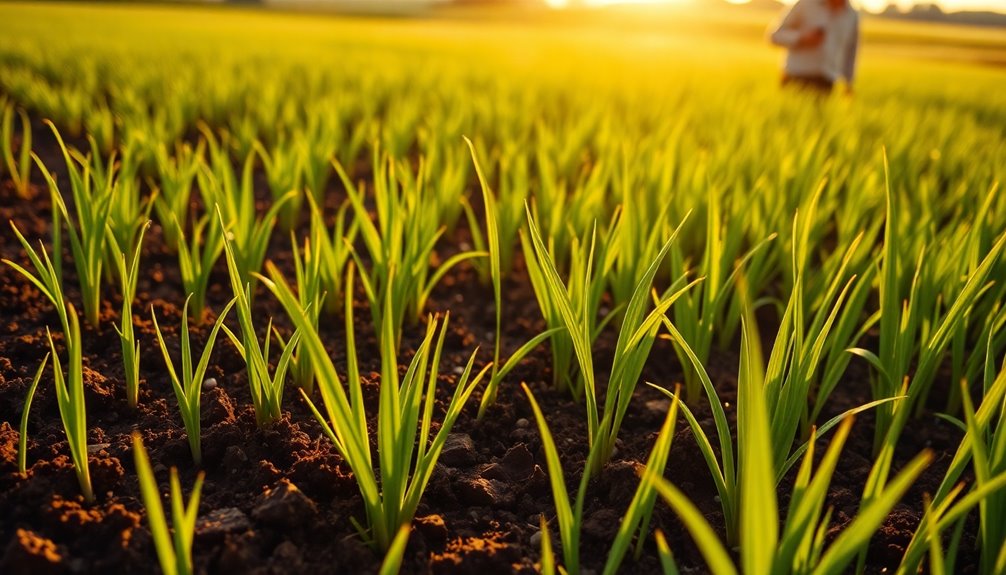
Timing is essential when establishing forage grasses, as it directly impacts germination success and overall plant health. To achieve successful establishment, you'll want to focus on the ideal planting timing for different types of grasses.
For cool-season grasses, aim to seed between August and November. On the other hand, warm-season grasses should be planted in late spring to early summer, ensuring soil temperatures reach at least 65°F.
Avoid planting during May and early June when hot and dry conditions can hinder growth. Instead, consider mid-March to mid-April for spring seeding, waiting at least four weeks after the last killing frost to promote healthy grass establishment.
Soil moisture is vital for seed germination and seedling survival, so postpone planting if conditions are excessively dry. Additionally, if you're planning late summer grazing, time it with shorter days to allow grasses to store nutrients before dormancy.
Nutrient Management Strategies
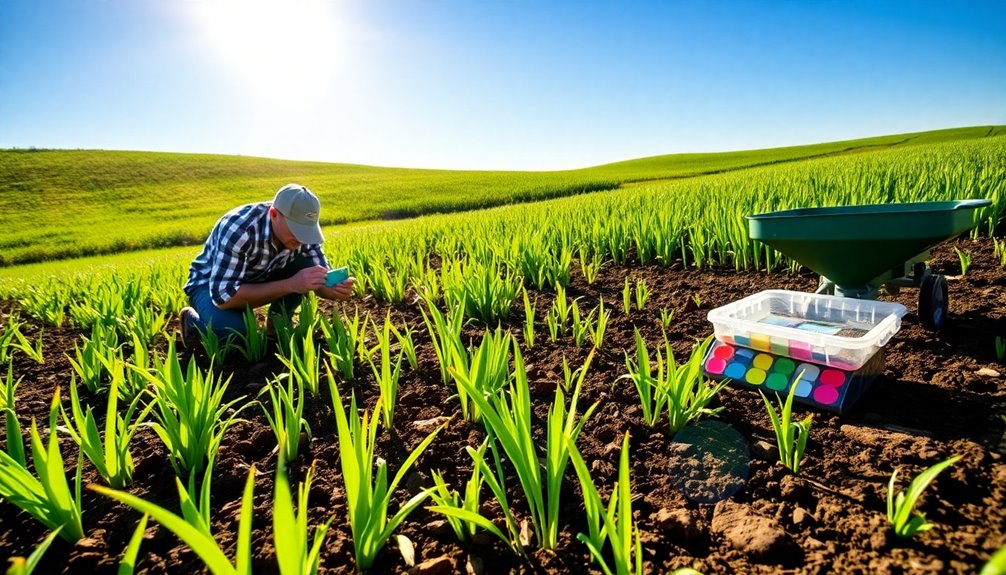
To establish healthy forage grasses, you'll want to focus on effective soil fertility planning and nutrient application techniques.
Conducting a soil test ahead of time will help you understand the necessary adjustments for ideal growth.
Soil Fertility Planning
Proper soil fertility planning is essential for establishing successful forage grasses, and it should start 6-12 months ahead of planting. By taking the time to assess and adjust your soil conditions, you'll set the stage for a thriving pasture.
Here are key steps to take into account:
- Test your soil: Obtain accurate soil samples to determine current nutrient levels and pH.
- Adjust soil pH: Aim for a pH of 5.8-6.2 for grasses and 6.0-6.8 for legumes. Apply lime as needed, ideally 6-12 months before seeding.
- Tailor nutrient applications: Based on soil tests, develop a customized fertilizer plan to support grass growth.
- Apply nitrogen wisely: Use small, frequent doses during active growth periods to enhance plant development and reduce nutrient leaching.
- Monitor nutrient levels regularly: Keep an eye on phosphorus and potassium to guarantee ideal root development and stress resilience.
Nutrient Application Techniques
Effective nutrient application techniques are essential for establishing robust forage grasses. Start by conducting soil tests to accurately assess pH and nutrient levels. Aim for a pH of 5.8-6.2 by incorporating lime or dolomite before disking the soil. Applying phosphorus at seeding supports root development, while small, split applications of nitrogen during active growth help prevent nutrient leaching and promote healthy seedlings.
Here's a quick overview of key nutrient management strategies:
| Technique | Purpose |
|---|---|
| Soil Tests | Assess pH and nutrient levels |
| Lime/Dolomite Application | Adjust pH for ideal growth |
| Phosphorus at Seeding | Support root development |
| Split Nitrogen Applications | Prevent nutrient leaching |
| Composted Organic Matter | Enhance soil fertility and moisture retention |
Monitor nutrient levels regularly and avoid applying fertilizers to drought-stressed seedlings, as this can lead to injury and hinder establishment. By following these nutrient application techniques, you'll set your forage grasses up for success and enjoy a lush pasture in no time!
Effective Weed Control

Weed control is essential for the successful establishment of forage grasses, and it starts even before planting. To achieve effective weed control, you need to eliminate weed competition prior to sowing your seeds. Often, this involves a glyphosate application during active weed growth to prepare a clean field.
Here are some key steps to take into account:
- Use a combination of herbicides and mechanical cultivation for thorough weed management.
- Monitor for weed infestations regularly after establishment to catch issues early.
- Implement integrated pest management (IPM) strategies, including using resistant forage varieties.
- Conduct regular field assessments to minimize weed impacts on pasture health.
- Plan for follow-up herbicide applications tailored to specific weed types and their growth stages.
Grazing Management Practices

When managing grazing, it's essential to pay attention to ideal grazing height and implement rotational practices to maintain pasture health.
By regularly monitoring grass growth and adjusting your grazing schedule according to seasonal changes, you can enhance forage quality and availability.
Let's explore how these strategies can benefit your pasture and livestock.
Optimal Grazing Height
Establishing the right grazing height is fundamental for maintaining healthy forage grasses. The ideal grazing height for most grasses is between 6 to 8 inches before grazing. This height guarantees adequate leaf area for photosynthesis, promoting plant health.
After grazing, it's essential to allow the grasses to recover to a height of 3 to 4 inches, which supports vigorous regrowth and overall pasture health.
To effectively manage grazing, consider these key points:
- Monitor grass growth regularly to determine the right grazing time.
- Begin grazing only when grass reaches at least 6 to 7 inches in height.
- Prevent overgrazing to maintain robust root systems and avoid pasture degradation.
- Implement rotational grazing practices to give pastures time to recover.
- Aim for sufficient land, ideally 20 acres or more, to support pasture recovery between grazing periods.
Rotational Grazing Benefits
Maintaining the right grazing height not only supports healthy grasses but also sets the stage for effective rotational grazing practices. By moving your livestock between pastures, you allow for adequate recovery time, which encourages healthier grass regrowth and minimizes overgrazing pressures.
Keeping pasture height at 6-8 inches before grazing guarantees that grasses have enough leaf area for photosynthesis, boosting energy production.
Rotational grazing greatly enhances weed management, as it prevents any single plant species from dominating the landscape. This method fosters established pastures, increasing organic matter and microbial activity in the soil, which improves nutrient cycling and resilience.
You'll notice that pastures managed through rotational grazing can yield up to 30% more forage compared to continuously grazed ones.
Regularly monitoring pasture growth and adjusting your grazing schedules based on weather conditions are essential elements of successful pasture management. Additionally, understanding the importance of financial planning for elder care can help ensure that sustainable practices are maintained for future generations.
Seasonal Pasture Management
Regularly adjusting your grazing management practices to align with seasonal changes is vital for enhancing pasture health. By doing this, you can guarantee your pasture remains lush and vibrant throughout the year.
Here are key strategies to take into account:
- Maintain pasture height of at least 6-8 inches before grazing to promote ideal recovery.
- Implement rotational grazing on a minimum of 20 acres to allow grazed areas time for regrowth.
- Monitor grass growth closely; don't let horses graze until grass reaches 6-7 inches to prevent overgrazing.
- Assess seasonal variations to determine hay needs and pasture availability.
- Avoid overgrazing, which can lead to soil degradation and create issues like mud in winter and dust in summer.
These practices not only help guarantee moisture for seed germination but also support the unique growth habit of each forage species.
Ongoing Maintenance Techniques

Consistently evaluating your pasture's health and growth is essential for ensuring optimal performance. Regular assessments help you spot signs of stress early, allowing you to adjust your management practices to foster ideal forage growth.
Implementing rotational grazing is a key strategy; it lets your pasture recover, promoting healthy root systems while reducing overgrazing pressure.
Soil fertility plays a significant role in maintaining lush pastures. Conduct periodic soil tests to gauge nutrient levels and apply fertilizers as needed to support robust forage growth. You can also engage with local agricultural extensions and county agents for tailored advice on ongoing maintenance techniques and any challenges you may face.
Additionally, continuous monitoring for weeds and pests is essential. Employ integrated pest management (IPM) strategies to keep populations in check, ensuring that weeds don't compete for resources.
By focusing on these ongoing maintenance techniques, you can create a thriving pasture that not only supports livestock but also enhances your overall land productivity.
Risks of Inadequate Management

Inadequate management of newly established forage grasses can have serious consequences for livestock health and pasture productivity. If you don't monitor your pasture properly, you risk not just your grasses but the well-being of your animals.
Here are some key risks to contemplate:
- Digestive Upset: High fructan content in spring grass can lead to colic, diarrhea, and laminitis in livestock.
- Microbial Disruption: Sudden dietary changes can cause rapid fermentation in the hindgut, disrupting microbial populations.
- Health Issues: Excessive non-structural carbohydrate (NSC) intake may heighten insulin responses, increasing the risk of metabolic disorders in horses.
- Overgrazing: This can damage pasture health, leading to higher NSC content and reduced root growth, ultimately compromising grass resilience.
- Dietary Shifts: Failing to implement gradual changes can pose significant risks for sensitive animals, necessitating careful management.
To maintain lush pastures, guarantee adequate moisture, healthy soil, and a strategic grazing plan.
With the right management practices, you can safeguard both your forage and livestock, promoting a thriving agricultural ecosystem.
Evaluating Pasture Health
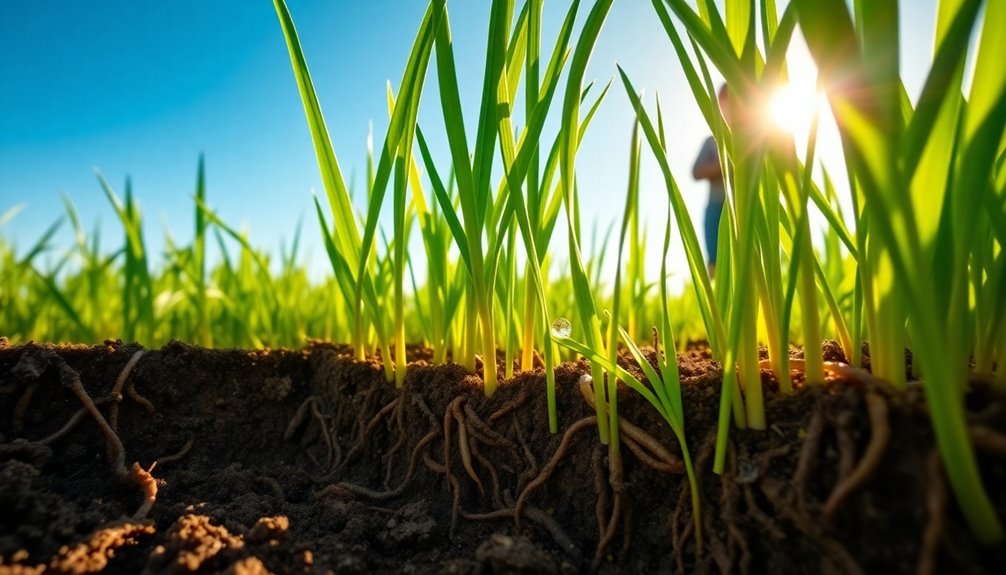
Evaluating pasture health is crucial for ensuring your forage grasses thrive and your livestock remain healthy. To start, regularly assess the percentage of desirable species, aiming for at least 75%. This benchmark helps you avoid the need for renovation.
Keep an eye on soil fertility by monitoring pH levels, ensuring they stay between 5.8 and 6.2. This range fosters ideal growth for your grass pastures.
You should evaluate forage density and composition at least once a year. This assessment will guide you in determining whether overseeding or reestablishment is necessary based on the proportion of desirable species present.
Implementing a rotational grazing system is also essential. It promotes pasture recovery while maintaining overall pasture health through consistent monitoring of grass growth.
Don't forget to watch for pests and diseases. Regular monitoring allows you to intervene promptly, safeguarding your pasture's productivity.
By staying proactive in these areas, you can maintain robust pasture health, ensuring your forage grasses flourish and your livestock stay healthy.
Innovative Pasture Renovation Methods

Innovative pasture renovation methods can transform underperforming grassland into thriving ecosystems. By using techniques like overseeding, you can enhance the quality and density of existing pastures without starting from scratch. This approach is particularly effective when your pastures contain 40-75% desirable species.
Here are some key strategies to evaluate:
- Overseeding: Introduce desirable forage species to improve overall pasture quality.
- No-till seeding: Reduce soil disturbance, conserve moisture, and facilitate quicker establishment of new species, especially in erosion-prone areas.
- Incorporate compost: Adding composted organic matter boosts soil fertility and seed germination rates.
- Regular soil testing: Conduct soil tests to adjust pH and nutrient levels, ensuring ideal conditions for new growth.
- Rotational grazing: Implement this strategy during renovation to help existing forage recover while allowing new grasses to grow without competition.
Frequently Asked Questions
What Is Lush Pasture?
Lush pasture is a vibrant, dense area of grassland that thrives, providing high-quality forage for your livestock.
You'll notice its vigorous growth and diverse plant species, which are essential for healthy grazing.
Achieving a lush pasture involves careful planning and management, like selecting the right forage varieties and maintaining soil health.
When properly managed, this environment not only nourishes your animals but also supports biodiversity and enhances soil quality, benefiting your entire agricultural system.
How to Establish a New Pasture?
"You reap what you sow."
To establish a new pasture, start with a solid plan. Test your soil for pH and nutrients, then enhance it with organic matter.
Choose the right forage varieties for your climate, like bahiagrass in the Florida Panhandle. Plant at ideal times, usually mid-March to mid-April or mid-June to July.
Control weeds effectively before planting, and consider rotational grazing for healthy, thriving grass. Your efforts will pay off!
What Is Forage Grass?
Forage grass is a type of grass specifically grown for grazing livestock and producing hay or silage.
You'll find varieties like bahiagrass, bermudagrass, and fescue, each chosen based on your local climate and soil conditions.
These grasses grow quickly and recover well from grazing, making them essential for livestock production.
Plus, they enhance soil health, prevent erosion, and support biodiversity, ensuring a thriving pasture ecosystem for your animals.
What Are the Major Factors That Affect Selection of Pasture Grasses?
When you think about lush green pastures, several factors come into play for selecting the right grasses.
Imagine the sunlight filtering through trees as you consider your local climate, soil conditions, and the resilience of native species.
You've got to factor in disease resistance and growth rates, too.
Collaborating with local experts and conducting soil tests will help you find the perfect mix that'll thrive in your unique environment, ensuring a vibrant pasture.
Conclusion
By following these steps, you can create a lush pasture that thrives year after year. Just like a well-tuned guitar, every element—planning, plant selection, and maintenance—needs to harmonize for ideal growth. Don't overlook the importance of ongoing care and innovation in pasture renovation. With your dedication and the right strategies, you're not just sowing seeds; you're cultivating a sustainable future for your land and livestock. Get ready to enjoy the fruits of your labor!



